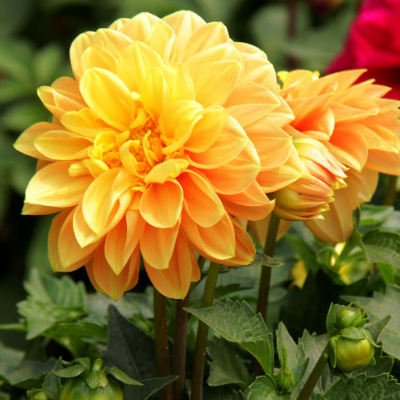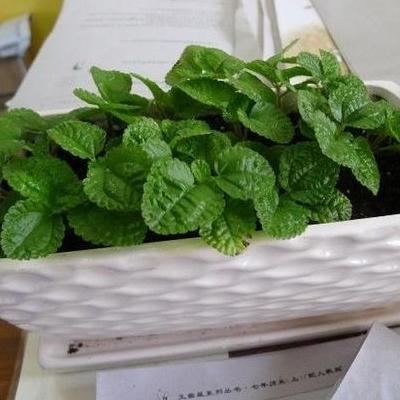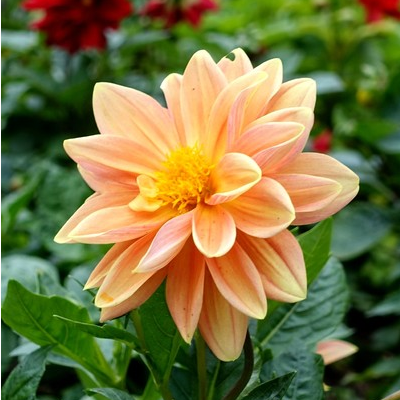The difference between the cultivation method of dahlia and dahlia
Speaking of dahlias, many people know it, but Xiaoli is a completely different flower, so the breeding method of Xiaoli? What's the difference between Xiaoli and Dahlia?

The culture method of Xiaoli flower:
1. Soil
Potted Xiaoli needs to choose a suitable medium, which can be made by mixing garden soil, cinder and fine sand, or adding some rotten leaf soil. Spread broken tiles at the bottom of the flowerpot as a drainage layer, put in the medium, you can add some base fertilizer appropriately.
2. Light and temperature
The growth of Xiaoli flower needs sufficient light, the daily light had better not be less than 6 hours, not excessive sunshade, so as to avoid poor growth. In spring, autumn and winter, Xiaoli can be exposed to direct light, but in hot summer, direct light can be avoided and can be maintained in bright places. In terms of temperature, Xiao Lihua likes a cooler environment and is more afraid of heat. When it is hot and sunny in summer, it should be properly shaded, or spray water to cool down. It is also not resistant to frost and cold. When the temperature drops below 10 ℃, it will go into dormancy. The suitable growth temperature of Xiaoli is between 15 ℃ and 28 ℃.
3. Water and fertilizer management
Xiao Lihua does not have high requirements for water and fertilizer, watering is generally more in summer, less in spring and autumn, keep the basin soil not dry and wet, avoid stagnant water in the basin, and pay attention to drainage in rainy seasons. When fertilizing, base fertilizer should be fully applied during planting, thin liquid fertilizer should be applied every 10-15 days, and some 1% Mel 3% potassium dihydrogen phosphate should be applied during flowering to promote flowering.
Matters needing attention in the cultivation of Xiaoli
1. Pruning
In the breeding process of Xiaoli, in order to control the flower pattern and promote flowering, pruning can be carried out. In the period of growth, often pick the heart, can make Xiaoli more branched, branches dense. In the process of growth, some withered and diseased leaves can be cut off to promote the healthy growth of Xiaoli.
2. Methods of reproduction
The propagation of Xiaoli flower is mostly propagated by individual plant and ball, or by cuttage.
3. Pest control
The diseases and insect pests of Xiaoli flower are not common, but there will be powdery mildew, brown spot, virus disease and the harm of borer larvae, which need to be detected in time and controlled in advance.
The difference between Xiaoli and Dahlia:
I. appearance features
1. Xiao Lihua. Xiaoli is relatively small, with a height of only 20 cm to 60 cm. A total stem can produce many flowers with a diameter of 5 cm to 7 cm. It has many colors, such as crimson, fuchsia, yellow, white and so on. The shape of the flower is also more changeable. Xiaoli blossoms every day from July to October and harvested from October to November. if the flowers are in good environmental conditions, they can blossom in all seasons.
two。 Dahlias. The plant of dahlia is much taller, usually growing to 1.5 m to 2 m, and stout. Its pedicel is longer, usually drooping, with a width of between 6 cm and 12 cm. The color of the flower is usually white, red and purple. It has more flower shapes and is richer than Xiaoli. Dahlia blossoms from June to September and harvested from September to October.
2. Growth characteristics
1. Requirements for lighting conditions
(1) Xiaoli likes plenty of sunshine and is suitable to grow in a mild and cool climate.
(2) Dahlia likes semi-cool environment, if the sun is too strong, it will seriously affect its flowering, especially in the period when the seedlings are relatively small, it must not be exposed to strong light, but the sun time needs to reach 10 to 12 hours.
two。 Requirements for temperature conditions
(1) Xiaoli likes a colder climate and can't stand the hot environment, so it grows very slowly in summer. In addition, it can't stand frost. If the temperature is less than 10 degrees Celsius, it will stop growing. The most suitable temperature is 15 to 28 degrees Celsius.
(2) in the cool climate, Dahlia blossoms best in late September, but it is not resistant to frost. Its stems and leaves will wither immediately after frost. Growth period for temperature requirements are not high, 8 degrees Celsius to 35 degrees Celsius can grow.
3. The requirement for moisture
(1) when Xiaoli is planted in a pot, we must be careful not to accumulate water, otherwise the roots will rot very easily, and the pot soil should not be too dry or too wet. When blooming, we should water more in summer and less in spring and autumn.
(2) Dahlia is not resistant to drought or waterlogging, and it needs to pour the basin to drain water on continuous rainy days.
All right, guys, you all understand clearly, you know the difference between dahlia and Xiaoli.
Culture methods and matters needing attention of Xiaoli flower 1. Morphological characteristics
Xiaoli flower is similar to Dahlia in shape, it is a dwarf type variety group of Dahlia varieties, but the plant is relatively small, with a height of only 20 to 60 cm, many branches, heads, several flowers can be planted on a total pedicel, and the flower stem is 5 to 7 centimeters. the flower color is dark red, purple, pink, yellow, white and other colors, the flower shape is rich in variety, and there are single and double, in a suitable environment can blossom all the year round. It has low plant and long flowering period.
2. Growth habits
The suitable temperature for growth is 10: 25 ℃, which is not only afraid of heat, but also not cold-resistant. when the temperature is 0 ℃, the root is frozen, and the plant growth is stagnant in the area of high temperature and rain in summer, which is in a semi-dormant state, which is not tolerant to drought, more afraid of waterlogging, avoid heavy clay, and rot after soaking. Requires loose, fertile and smooth drainage of the rare loam, low-lying stagnant water is not suitable for planting.
3. Geographical distribution
Native to Mexico on a plateau 1500 meters above sea level.
The culture method of Xiaoli flower
Xiaoli is an excellent ground cover plant, also known as Xiao Li Chrysanthemum, Xiao Li Hua, etc., for Compositae Dahlia perennial bulb herbs, low plants, long flowering period, representing hope and vision, can be arranged flower beds, flower borders and other places, can also be potted ornamental or cut flowers to use, with a very high ornamental value, let's take a look at the breeding methods of Xiaoli!
The growth habits of Xiaoli
Xiaoli sex like sunshine, appropriate mild climate, growth temperature of 10: 25 ℃ is better, both afraid of heat, and not cold-resistant, temperature 0 ℃ tuber root frozen, summer high temperature and rainy area plant growth stagnation, in semi-dormancy state, not resistant to drought, more afraid of waterlogging, avoid heavy clay, root rot after being soaked. Loose, fertile and well-drained sandy loam is required, and low-lying stagnant water is not suitable for planting.
Propagation methods of Xiaoli Flower
1. Bulbs: there are bulbs or bulbs, tubers and roots in the underground part of Xiaoli. These bulbs or bulbs, tubers and roots grow around them after growing in the ground for a year. Just divide these balls and plant them. Easy to operate and easy to manage. Just be careful not to plant the ball too deep when planting, and usually cover the soil no more than twice the diameter of the ball.
2. Ramet: the ramet of Xiaoli should be carried out after the soil was thawed in early spring. Take the mother plant out of the flowerpot, shake off the excess potted soil, separate the root system as much as possible, and cut it into two or more plants with a sharp knife, each with a considerable root system. and its leaves are properly trimmed to facilitate survival.
3. Cuttage: the terminal bud, axillary bud and foot bud of Xiaoli flower can be cut to root after germination, and the foot bud seedling is strong in resistance to diseases and insect pests. Generally, the tubers were planted in a plain sand basin in the first ten days of March, kept moist, and germinated at room temperature above 15 ℃. When the foot bud grows 2 true leaves, break it from the root and insert it into the vegetarian sand to promote the root. Spray water 2 or 3 times a day and take root in more than 20 days.
The culture method of Xiaoli flower
1. Pot: Xiaoli flowerpot soil is made of 5 parts of garden soil, 3 parts of fine sand or slag and 2 parts of barnyard manure. Broken tiles should be added to the bottom of the pot as drainage layer. Seedlings with 10 cm basin, slow seedling after watering once thin cake fertilizer water, before the seedling height of 20 cm before budding, change the basin twice, each time to add new rotten leaf soil to enrich the edge of the basin.
2. Illumination: Xiaoli is fond of sunlight, sufficient light is beneficial to the growth of Xiaoli, ensuring 6-10 hours of light every day, if long-term shade, lack of light, then poor growth, few flowers, easy to get sick.
Temperature: Xiaoli likes cold and heat, the temperature in northern China is more suitable, from the Summer Solstice autumn will blossom, while the Yangtze River basin, summer high temperature, in a semi-dormant state, must be foliage shade, spray cooling.
4. Watering: Xiaoli flowers have luxuriant branches and large water consumption. If there is a lack of water to strengthen the light, the leaves will be scorched at the light, and the leaves will be withered if they are heavy. If there is too much water, the root is easy to rot, so the pot soil should be neither dry nor wet, flowering period, summer watering should be more, spring and autumn should be less, rainy days should prevent stagnant water, put the flowerpot high, before the autumn harvest, less or no watering.
5. Fertilization: Xiaoli likes fertilizer. In addition to applying sufficient basic fertilizer, 10% cake fertilizer and water are applied every 10 to 15 days during the growing period except in the middle of summer. After budding, 1% potassium dihydrogen phosphate is applied to promote the flower color.
6. Pruning: when cultivating only Xiaoli flowers, remove the lateral buds and leave the main branches. the potted plants should control the height, remove all the axillary buds from the base, pick along with the growth, and leave only one flower in the terminal bud. When cultivating four Xiaoli flowers, when the seedling height is 10cm to 15cm, two segments are left at the base to form four lateral branches, each of which has only one terminal bud and can produce four flowers.
7. Pruning: if Xiaoli wants to blossom on National Day, it can be renewed and pruned after blooming in early July, twisting the branches to be cut first, leaving a height of about 20cm, then cutting after wilting, properly controlling water after cutting, and picking out the core according to the requirements of culture, generally carefully cultivated for 2 months, which can blossom on National Day.
Pest control of Xiaoli flower
1. Powdery mildew
Powdery mildew is harmful to leaves, pedicels and buds, which appears nearly round white powder layer spots, expands into powdery powder layer mottled, leaves twisted and withered. The pathogen spent the winter in the diseased body and spread by air, and the disease was serious from September to October.
[prevention and treatment] at the initial stage of the disease, 2% antimycin 120 aqueous agent 100 times 200 times or 40% polysulfide suspension 800 times, sprayed once in 10 days, 2 times in succession.
2. Brown spot
[harm] after the leaves were infected, the yellowish dots first appeared, expanded and sunken, and finally formed a near-round central gray-white, edge dark brown white disease spot, with a wheel pattern, 1mm in diameter, and a light black mildew on the surface. The pathogen wintered in the remnants of diseased leaves, and the disease was serious from June to August.
[control] it can be controlled 600 times with 1% Bordeaux solution or 75% chlorothalonil.
3. Virus disease
[harm] showing symptoms such as mosaic, chlorosis, dwarfing and so on. The viruses are Xiaoli mosaic virus, cucumber mosaic virus, tomato spot wilt virus, tobacco line virus, leafhopper and aphids.
[prevention and control] non-toxic breeding materials can be selected to control virus-transmitting insects.
4. Plutella xylostella
[harm] the larvae are yellowish or reddish, with 2 or 3 generations a year, and the larvae are harmful from June to August.
[prevention and control] 50% fenitrothion can be sprayed 1000 times, such as moth-eaten stem, 100 times 200 times omethoate can be injected.
- Prev

The difference between the culture method of wrinkled leaf mint and round leaf cold spray
Wrinkled leaf mint, which is also a kind of peppermint, is really not as good as mint. What is the breeding method of wrinkled leaf mint? What is the difference between wrinkled-leaf mint and round-leaf cold spray: the culture method of wrinkled-leaf mint: wrinkled-leaf mint is a kind of plant that is slightly resistant to freezing, and the brief low temperature in winter will not freeze to death.
- Next

Does Xiaoli blossom in winter? what are the ways of reproduction?
Xiaoli is different from Dahlia. These are two different plants. Does Xiaoli blossom in winter? What are the breeding methods of Xiaoli flower? Does Xiaoli blossom in winter: the florescence of Xiaoli is very long, and due to different climatic and environmental conditions in different regions, the flowering period is also different.
Related
- Fuxing push coffee new agricultural production and marketing class: lack of small-scale processing plants
- Jujube rice field leisure farm deep ploughing Yilan for five years to create a space for organic food and play
- Nongyu Farm-A trial of organic papaya for brave women with advanced technology
- Four points for attention in the prevention and control of diseases and insect pests of edible fungi
- How to add nutrient solution to Edible Fungi
- Is there any good way to control edible fungus mites?
- Open Inoculation Technology of Edible Fungi
- Is there any clever way to use fertilizer for edible fungus in winter?
- What agents are used to kill the pathogens of edible fungi in the mushroom shed?
- Rapid drying of Edible Fungi

